How To Build A Gaming PC, Plus Sample Builds To Get You Started
Whether you're building a high-end performance machine or a budget-friendly PC, we've got you covered.
Building your own gaming PC is a rewarding experience and gives you far more control over the pieces and parts that wind up in your PC tower. Those without any familiarity of the internal workings of a PC may think that the process is too daunting and and opt for a pre-built PC. But if you're in that camp, you'll probably be surprised to learn that building your own PC isn't nearly as colossal of an endeavor as it used to be. If you're interested, we've created this handy guide to teach you how to build your own gaming PC. We've also included a couple of sample builds below that you could follow in order to build a high-end or budget gaming PC.
Before we dive in, we should note that this guide only covers the actual PC. You'll have to pair it with a monitor, keyboard, and mouse (at the bare minimum). For suggestions on which peripherals to pick up, check out our roundups of the best gaming keyboards, best gaming mouse, best PC gaming headsets, best PC controllers, and best cheap gaming monitors.
- A look at some gaming PC builds
- Tools
- Terms to know
- How to build a gaming PC
- Step 1: Prepare your motherboard
- Step 2: Install the CPU
- Step 3: Install M.2 SSD(s)
- Step 4: Install the RAM
- Step 5: Get your case ready for your motherboard
- Step 6: Install your motherboard into your case
- Step 7: Install your power supply (PSU)
- Step 8: Connect any SATA hard drives/SSDs
- Step 9: Plug your case and power cables into the motherboard
- Step 10: Install your CPU cooling system
- Step 11: Start cable management
- Step 12: Install your graphics card
- Step 13: Install your OS
- If your PC doesn't turn on
A look at some gaming PC builds
Before we get to the actual building portion, we need to talk about finding and buying the parts for your PC. Finding the right parts can be confusing -- and expensive. Gaming PCs can cost as little as $500, or as much as several thousand dollars to build. Obviously, more expensive parts usually mean more power, but shopping for a build that fits your budget is often the biggest obstacle for first-time builders. There are several components that you need, each with a plethora of models, specs, and compatibility requirements to consider.
We know this can be overwhelming, so we created example builds from hardware available at the time of writing. The first is a high-end rig powerful enough for bleeding-edge gaming performance, and the other is a more affordable $1000 build that will run most games at decent settings.
That said, take our example desktops as suggestions rather than strict loadouts, since many online stores are experiencing product shortages and shipping delays due to the global chip shortage. We can’t guarantee every part in our lists will be available, or even the same price, at a given time. In that case, refer to resources like PC Part Picker or Newb Computer Build’s example builds to find suitable replacements.
Last note: Our example builds include all the necessary parts for modern PC gaming, but they only cover the PC itself. Optional parts, like optical drives, aren’t included, but you need one to play games or media off discs. We also skipped accessories, but our buying guides for the best gaming mice, best gaming headset, best capture card for streaming, best gaming keyboard, and best budget gaming monitors can help round out your build.
High-end gaming PC build
Exact price: $3,400
- MSI Gaming GeForce RTX 3070 -- $1,290
- Intel i9-9900K processor -- $750
- Gigabyte Z390 Aorus Ultra gaming motherboard -- $316
- 2x Crucial 1TB NVMe PCIe M.2 SSD -- $130 each
- G.Skill Ripjaws V Series 32GB RAM -- $134
- MSI MEG CoreLiquid S280 cooling system -- $243
- EVGA SuperNOVA 1000 G3 PSU -- $168
- Fractal Design Meshify C case -- $99
- Windows 10 Home -- $139
$1,000 gaming PC build
Exact price: $1,053
- MSI NVIDIA GeForce GTX 1650 Ventus XS -- $359
- Intel Core i5-12400Fprocessor -- $185
- MSI B560M-A PRO ProSeries Motherboard -- $98
- Crucial P1 500GB NVMe M.2 SSD -- $63
- Corsair Vengeance LPX 16GB RAM -- $69
- Cooler Master Hyper 212 Evo CPU cooler -- $35
- EVGA 500-watt ATX power supply -- $50
- Zalman S4 ATX Mid Tower case -- $55
- Windows 10 Home -- $139
Note: Prices above were accurate at the time of writing, but they are subject to change.
Tools
For the vast majority of your build, you'll be using a No. 2 Phillips screwdriver, but if you're installing M.2 SSDs into your motherboard, then you'll want to use a smaller No. 1 Phillips screwdriver for that.
Flashlight:
Thankfully, nearly every smartphone on the market can be used as a flashlight, and you’ll likely need it when installing certain cables and components into your case.
Thermal paste:
You'll want a tube of thermal paste to keep your CPU's temperature low during use. Most CPU coolers come with thermal paste already applied, which means you won't need any extra. However, if you do end up buying a tube of thermal paste, you can clean the cooler's paste off and use your own.
Terms to know
We've attempted to simplify the process of building a gaming PC as much as possible here, but if you're not familiar with PC hardware, some of the terms in this guide may need some clarification. We've briefly explained some of the parts and terminology we'll be using below. Feel free to reference this section as you work on your build.
GPU: GPU stands for graphics processing unit; another name for a graphics card. This will handle displaying images on your PC. The more elaborate and complex these images are, the more power you'll need from your graphics card. The two big names in the graphics card game are Nvidia and AMD.
CPU: The CPU (central processing unit, also known as a processor) handles all of the processes and calculations on your PC. For your PC, you'll choose a CPU from either Intel or AMD.
Motherboard: The motherboard is where all of the components are installed, allowing them to work together and perform their functions properly.
SATA: SATA is a type of connection, like USB, that is used for hard drives and SSDs to transfer data
PCIe: PCIe is another type of connection, though it's most commonly used for graphics cards and M.2 SSDs
NVMe: NVMe is a type of connection protocol that can be supported by M.2 SSDs. This provides much faster access to saving and accessing data.
M.2 SSD: An M.2 SSD is a small stick that provides your PC with storage space. You can get a SATA-based M.2 SSD or a PCIe-based M.2 SSD, the latter of which can support NVMe.
RAM: The RAM (or random access memory) is used to store data and information that is being processed by the CPU. The more RAM you have--paired with a good-quality processor--the faster your PC can perform its various functions.
Cooling system: The cooling system is used to protect the CPU from overheating.
PSU: The PSU (or power supply) supplies your PC and its various components with power.
OS: OS stands for operating system. Most gaming PCs will utilize Windows 10--it's what we suggest--though some people may want to install Linux.
How to build a gaming PC
Step 1: Prepare your motherboard
Parts used: Motherboard

Assembling the motherboard outside of the case will make your whole experience much easier to deal with. Our general rule of thumb is to install as many parts as possible before screwing it into your case. An important thing to note before starting on your motherboard is that you should refer to its manual as often as possible, as your specific motherboard may suggest specific ways or places to install your components. Also, keep in mind that certain parts will require some force when plugging them in, while others simply just need to be placed into their respective spots. Please pay close attention to the following instructions before installing your components.
The first thing you'll want to do is make sure you're assembling your PC on a flat surface. Don't build it on a carpet--the mixture of static electricity and your PC's parts is a dangerous combination and could cause damage to your components. It's unlikely to happen, but we still suggest touching your metal case from time to time to help ground yourself and avoid this from happening.
Instead, build your rig in a room with hardwood or laminate floors like a dining room or kitchen--we even went the extra mile and took our socks off. Take your motherboard out of its packaging and then place it on a flat surface. You can lay it directly on your table, but we personally placed it on top of its box to avoid scratching our desk. At this point, you're ready to start.
Step 2: Install the CPU
Parts used: CPU, motherboard
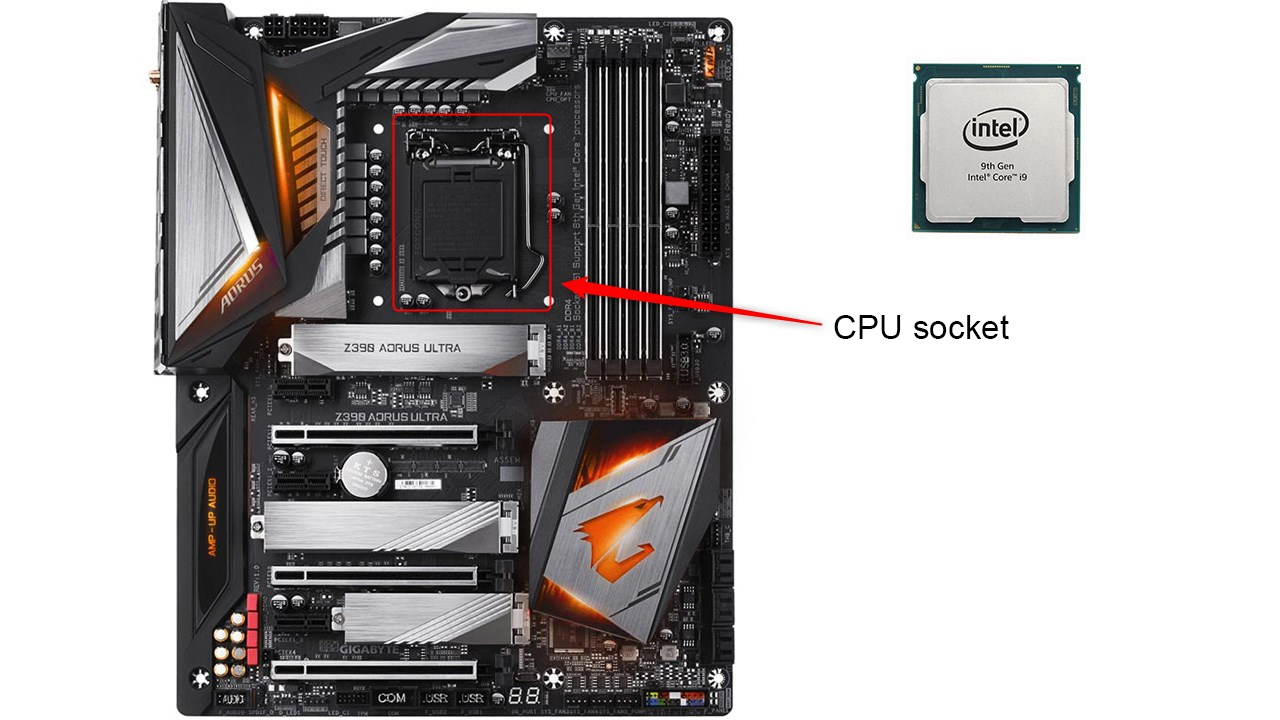
The easiest part of your entire build is also the first: installing our AMD Ryzen CPU. Your motherboard's CPU socket will be protected by a piece of plastic, which you'll be able to remove when you open the tray. All you need to do is gently push down on the tray's metal arm and pull it out. Once it's free of the tray, lift it up to open the socket and the protective plastic will fall out. Be sure to keep this plastic piece in case of any issues with your motherboard, as you'll need to reinsert it before sending it back to the manufacturer.
At this point, your CPU socket tray should be open, allowing you to install your CPU on to your motherboard. Your CPU should have some small half-circle indents in its board. The CPU socket is designed to fill these indents, making it easy to line up your CPU and install it properly. Once you've figured out how to place your CPU into its socket, do so gently. Do not apply pressure directly on the CPU--simply close the tray and make sure the metal arm is locked into its original position, which may require a bit of force.
Step 3: Install M.2 SSD(s)
Parts used: M.2 SSD(s), motherboard

M.2 SSDs are another easy step in the process, but don't forget to reference your manual to find out which M.2 slots you should use first. Your motherboard may have protective thermal guards on your M.2 slots, so remove those first. Once you've taken any guards off the motherboard, you can slot in your M.2 SSDs. These require a little bit of force to slot into their respective slots, but don't push too hard--they should slide in quite easily. Once the M.2 SSDs are in their slots, the opposite end should be pointing upward at a diagonal angle. At this point, you take the respective screw (that is often included with your motherboard), push each M.2 SSD down, and screw them into the appropriate spots. At this point, you can take the thermal guard and place it on top of each M.2 SSD, screwing it back into place.
Step 4: Install the RAM
Parts used: RAM, motherboard

This is another step where you'll want to reference your motherboard's manual, which should be able to tell you which order to place the RAM in. If you have four slots and only two sticks of RAM, then you should make sure the two sticks are spaced apart in either the first and third slot or second and fourth--your motherboard manual can advise you here. Placing your RAM apart like this will help you get the most out of your CPU. First off, be sure to flip down the plastic clips on both sides of each slot you plan on using. Inserting the RAM requires more force, but make sure you start small and then ramp up your pressure gradually. When you hear a click, your RAM is in its slot. This should cause the plastic clips to flip up, gripping your RAM. If you notice your clips haven't flipped up, then your RAM may not be seated properly.
Step 5: Get your case ready for your motherboard
Parts used: Case

It's almost time to throw your motherboard into your case, but first you'll need to screw in some standoff screws that you'll place your motherboard onto before screwing it in. These standoffs will come with your motherboard, and once you've located them, you can start screwing them into your case. There should be about a dozen holes for the standoffs to fit into. Refer to your case's manual if you're having trouble finding them. Once the standoffs are screwed in, you're ready to insert your motherboard.
Step 6: Install your motherboard into your case
Parts used: Motherboard, case
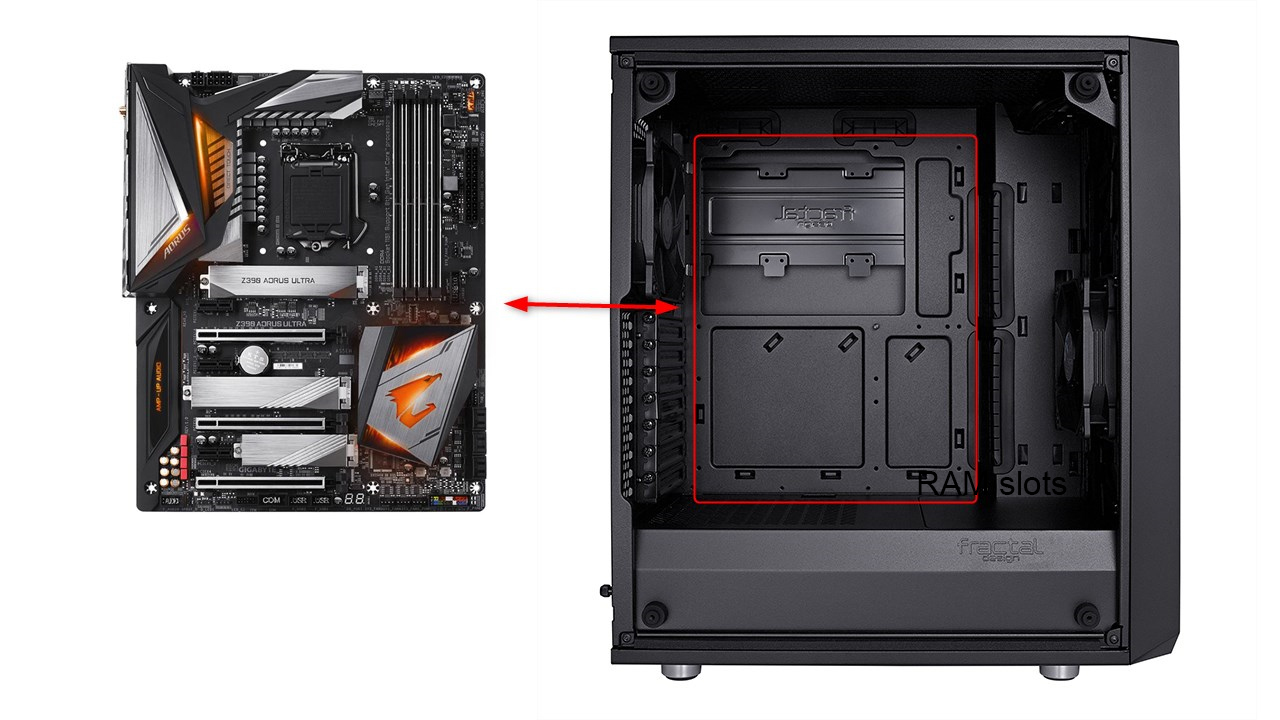
The standoffs make it easy to place your motherboard into your case, but don't start screwing it in straight away. There should be a space on the back of your case for your motherboard's I/O ports to fit into. It'll be a rectangle, and you'll want your motherboard to be inserted comfortably into this space so that you can access all of the ports. Once everything fits, you can start screwing your motherboard onto the standoffs with the appropriate screws. Don't forget that you don't want to screw anything too tightly. Just turn your screwdriver until everything is securely tightened, and then you're ready to move on.
Step 7: Install your power supply (PSU)
Parts used: Power supply, case, motherboard
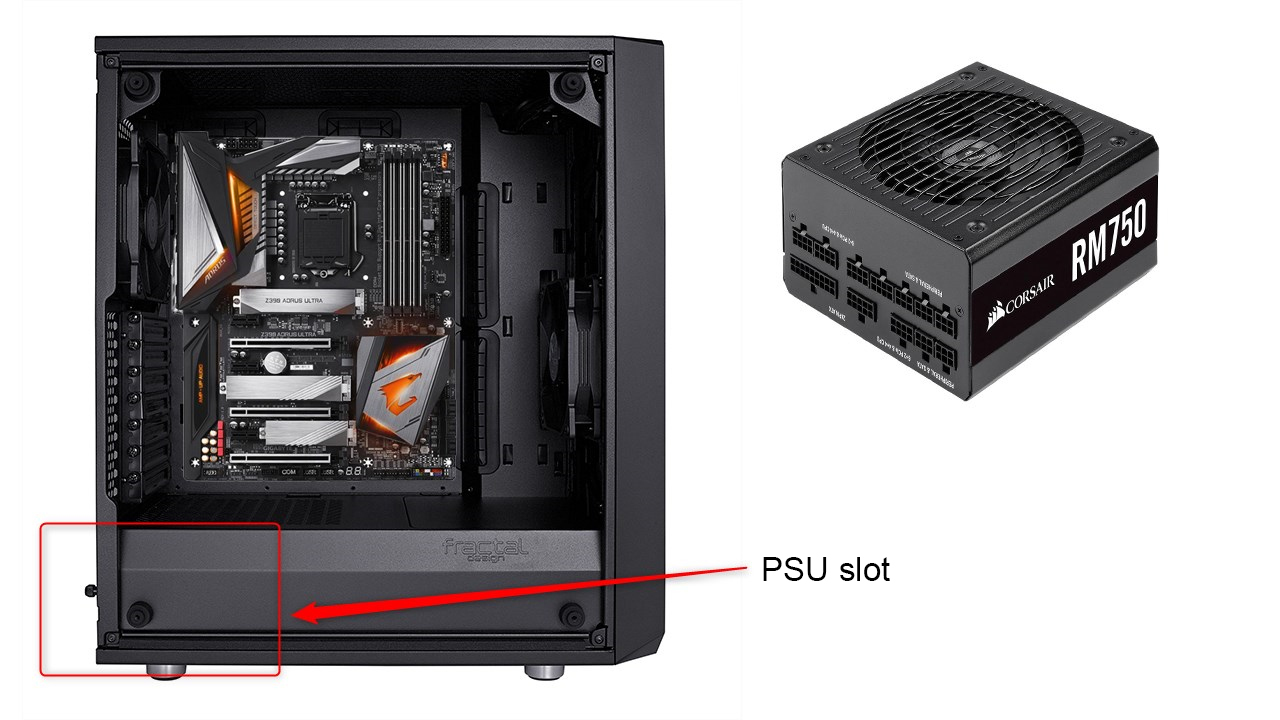
Installing the power supply into your case is often quite easy. You'll want to refer to your specific case's manual for this, but it's pretty straightforward. First, we took our case's mounting bracket and screwed it onto the back of our power supply. You'll notice your power supply also sports a fan, which is used to circulate air. If you're planning on placing your finished gaming PC on a hardwood floor or desk, then feel free to aim this fan downward; if you're placing your gaming PC on a carpeted floor, then you'll want to aim the fan upward.
Once you've figured out which way your PSU needs to be oriented, and screwed on the mounting bracket, you can easily slide it into your case and tighten the bracket's screws. Depending on how much room you have for your PSU, you may want to hold off on screwing it in until you've plugged in all of its various power cables.
Step 8: Connect any SATA hard drives/SSDs
Parts used: SATA drives, case, power supply
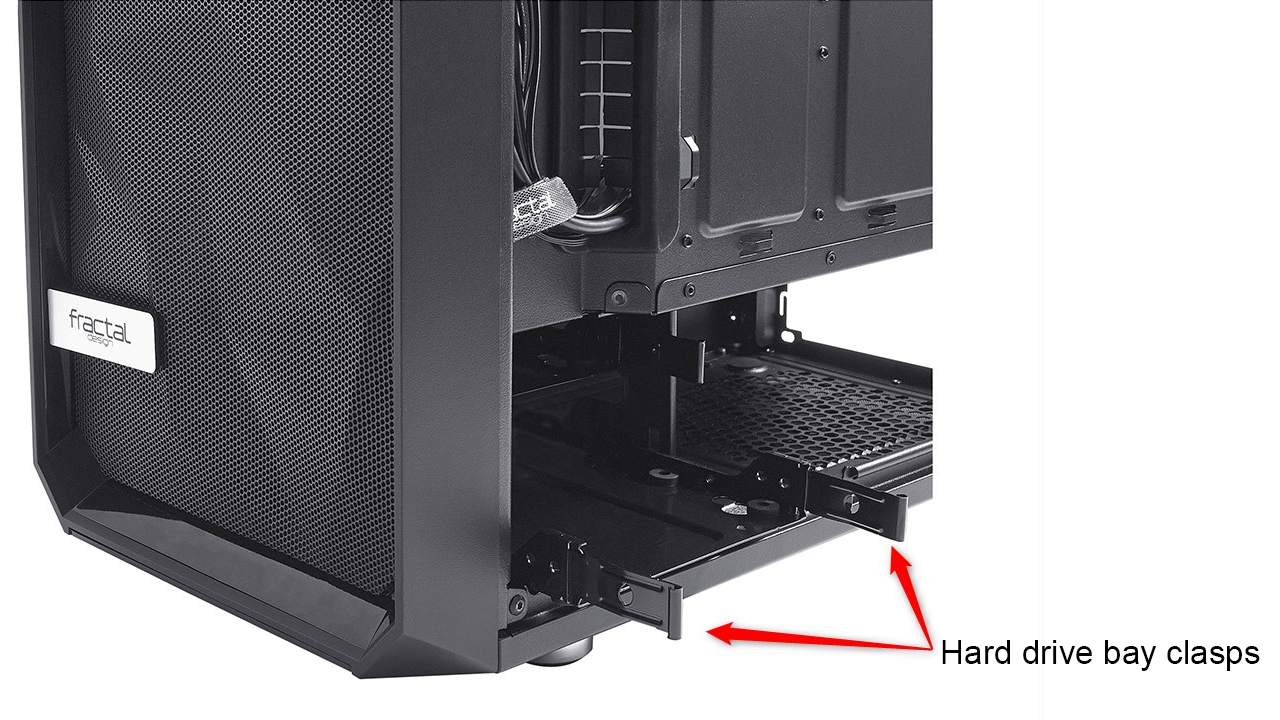
Now that the power supply is installed, you can start connecting any SATA hard drives or SSDs. Your case should have a specific bay area dedicated to holding these kinds of drives. Locate this area, then look for two metal clasps on the left and right side of each bay. Squeeze these clasps and then pull the bay out. Here is where you'll be able to screw in your SATA drive and keep it stable inside your case. Once this is done, you'll want to reinsert the bay into its place, and then plug a SATA and PSU cable into your hard drive. Find the SATA slot on your motherboard and plug the other side of the appropriate cable into it, then plug the other side of the PSU cable into your power supply. Your drive is now installed, though you will need to format it once your PC is up and running.
Step 9: Plug your case and power cables into the motherboard
Parts used: Case, power supply, motherboard

Now, you're ready to start plugging cables into your motherboard. This part requires some patience, as your case cables are extremely tiny and can be difficult to orient. You'll want to reference both your case and motherboard manuals during this step. Some motherboards, like our Aorus Ultra, come with a bus that you can plug the case cables into before inserting them into the motherboard. This makes this step much easier.
Your case cables make it so you can use the various ports on the front of your PC in addition to the power button itself. Of course, nothing is going to happen when you press that button if you don't plug your PSU into your motherboard. You'll want to plug the 24-pin ATX and EPS12V cables into their respective spots on both the motherboard and PSU. You'll be plugging in all of your power cables into the PSU, including fans, SATA drives, and your cooling system.
Step 10: Install your CPU cooling system
Parts used: Cooling system, CPU, motherboard

Installing your cooling system can be a somewhat nerve-wracking experience, particularly when applying the thermal paste, but it's a lot easier than it sounds. The first thing you need to do is mount the system's bracket to the motherboard. You'll need access to the back of the motherboard tray, as you'll be screwing part of it to the back of the tray. This'll give you the spots you need to set the cooler's pump onto your CPU and motherboard. Before you do this, however, there are a few other steps.
Liquid-based CPU cooling systems come with a radiator equipped with fans, which you'll want to screw into your case. Of course, you'll need to figure out where you want to install it. We recommend screwing it into your case's top grill, as it'll allow for more airflow, but some cases may not have a top grill, and you'll need to install it on the back of the case. Once you figure out what position you're going to go with, you'll screw the radiator into the grill itself. Once you're done this, you're ready to attach the pump.
First, you'll want to apply some thermal paste. Some coolers come with thermal paste already applied; if that’s the case, your cooler’s thermal paste is most likely capable of handling the job, and you may be able to skip this next step. You can also easily remove the cooler’s paste with a dry cloth if you bought thermal paste you’d rather go with. You'll want to apply a pea-sized glob of thermal paste into the center of your CPU. During this step, always go smaller than bigger. Once applied, you can press the cooler into its position on the CPU and thermal paste. If you feel like you've accidentally applied too much thermal paste, don't worry: It's as easy as wiping the CPU off with a dry cloth and rubbing alcohol and trying again.
Once the pump is installed, you'll want to make sure all of your cooling system's wires are plugged into the right spots. Our particular cooler required us to plug a micro-USB cable into our pump and the other side into our motherboard.
Step 11: Start cable management
Parts used: Case
Before we move on to the last step of physically building your PC, you may want to do some cable management to clean up. This'll create some room for air circulation and accessing your components if you ever want to upgrade later. Most cases come with Velcro straps or zip ties, but I always keep a bag of Velcros on hand just in case. The case we went with, Fractal's Meshify C, includes an awesome area for cable management that's equipped with a series of Velcro straps. It's located on the back of the motherboard tray. We were able to slide all of our cables into this space and keep it all fastened up nicely.
The only zip ties we used were for our CPU cooling system's wires, which were thin and plentiful. This made it easier for us to orient them through the holes in our case to reach our desired spot. Just make sure you don't over-tighten your zip ties as doing so could damage your cables.
Step 12: Install your graphics card
Parts used: Graphics card, motherboard

Finally, it’s time to discuss the component you're probably the most excited about. The graphics card is easy to install. First, you'll need to remove an appropriate number of expansion slot inserts from the back of your case to fit your graphics card. This will vary depending on which GPU you go with, but two is usually the safe number--our MSI GeForce RTX 2080 Ti takes up two. Once you unscrew and remove them, figure out which PCIe Express slot you'll need to insert your card into, then flip its plastic notch at the far end of the slot downward to prepare for installation. At this point, all you need to do is line up the graphics card with the PCIe Express slot and then push down until the plastic notch flips up and clicks. Again, you don't need a lot of force to push it in, but you will need to push the graphics card into its slot until you get that click. Once you hear that, you can screw your graphics card's mounting brackets into the case using the expansion slot's screws and holes.
At this point, you need to plug your graphics card into your power supply to give it power. (Low-end graphics cards don’t typically require extra power, so if that’s what you’re working with, you’re good to skip this step.) Take the appropriate cables included with your power supply and plug one end into the graphics card; then, plug the other into the PSU. It's okay if there are parts of the cables that go unused--just make sure every port on the graphics card has part of the cable plugged in.
Step 13: Install your OS
Parts used: USB thumb drive, case
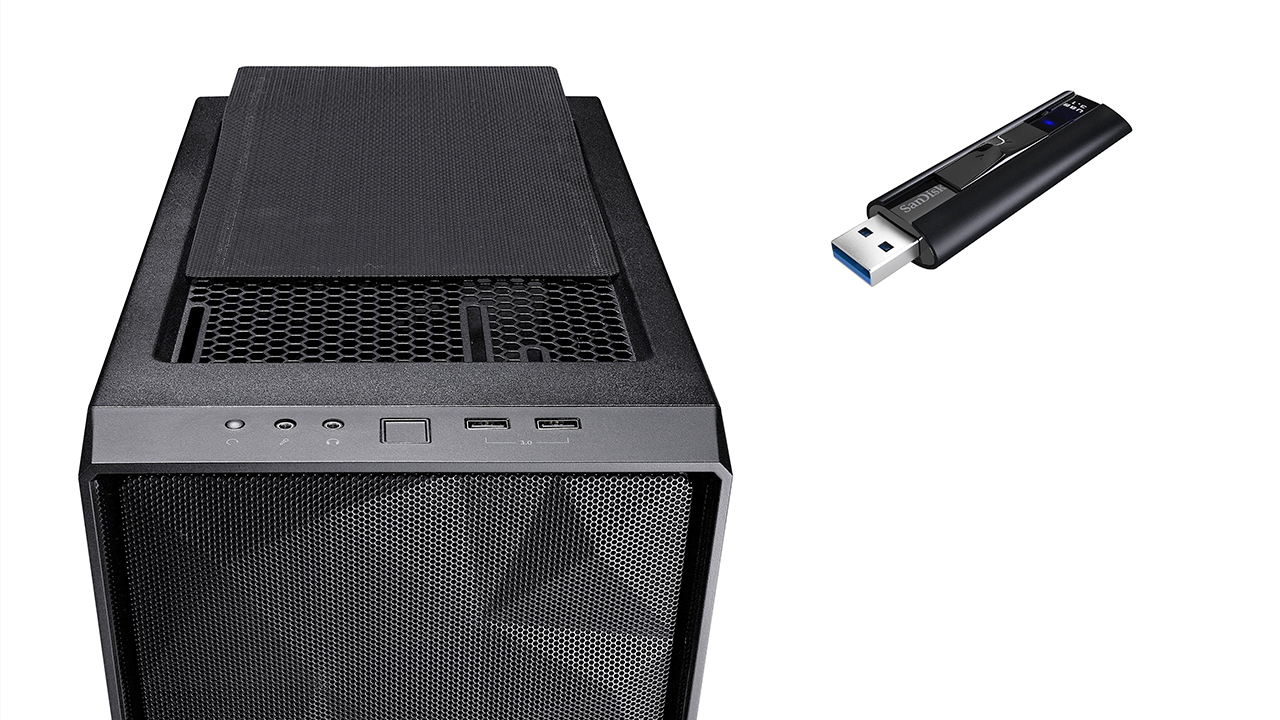
Once you've ensured a tidy PC with all of your cables managed, you should connect an HDMI cable to your PC and plug the other end into a monitor. Plug the power cable into your PSU and the other end into an outlet; then, flip the power switch on the back of your PC to its "On" position. Press the power button on your PC, and if it turns on, you're almost good to go.
At this point, you'll need another PC and a fast USB drive of at least 8GB--we suggest the SanDisk Extreme Pro. You'll then want to head over to Microsoft and follow the steps provided there. This will help you create an installation device out of your USB drive, which you can plug into your PC before booting it up. Upon starting your PC, it should go straight into the Windows 10 installation process. Follow the steps here and wait for it to install. Once you're done, you should be good to go, though you will need to buy a proper license for Windows 10 from Microsoft. If you do this from your new PC, it'll activate automatically. On this is all setup, you're good to go, barring the installation of an optical drive, if you chose to get one.
If your PC doesn't turn on
If your PC doesn't boot, don't worry: It's certainly not the end of the world. There are a number of things that can cause a PC to not boot up on your first try, and save for any product malfunctions, they're easily solvable. Here are a few things you can do to troubleshoot your powerless PC.
Is the power supply plugged into an outlet?
This is a simple fix. Just plug your PC into an outlet, and you should be good to go.
Is the power supply's switch turned on?
Make sure you've flipped your PSU's switch into the 'On' position before powering on. This is an easily overlooked issue with a solution that's just as easy.
Are your power supply cables seated in the motherboard properly?
This is the next thing you should double-check. Reconnecting the cables could be what you need to finally deliver power to your PC.
Are your case's cables plugged into your motherboard properly?
It's important to get this step right because if you push your case's power button and its specific cable isn't plugged in correctly, it won't be able to start your PC. Some motherboards come with a serial bus that you can plug your case's cables into before connecting to your motherboard.
Are your parts installed correctly?
This is the last thing to check as it can be the most time-consuming. Reconnecting your RAM and CPU or simply switching the RAM sticks into different slots could be the solution you're looking for.
If all this fails, then your components may be defective.
Unfortunately, this can happen. Sometimes when building a PC, you realize that one of your components isn't working correctly. At this point, you'll need to contact the manufacturer of your part and ask them about their return policy. The vast majority of big PC component manufacturers have return policies that will cover defective parts, so you don't have to worry. It just might take a little longer to enjoy your brand-new gaming computer.
More Tech Picks From GameSpot
- Best Computer Speakers For Gaming
- Best 4K TVs For Gaming
- Best Monitor For PS5, Xbox Series X
- + Show More More Tech Picks From GameSpot Links (6)
- The Best Gaming Chairs
- Best Cheap Gaming Monitors In 2022
- Best PC Headsets In 2023
- The Best Nintendo Switch Controllers You Can Buy
- The Best VR Headsets In 2020
- The Best Webcam For 2021: Top Picks For Streaming On Twitch And YouTube
Got a news tip or want to contact us directly? Email news@gamespot.com
Join the conversation